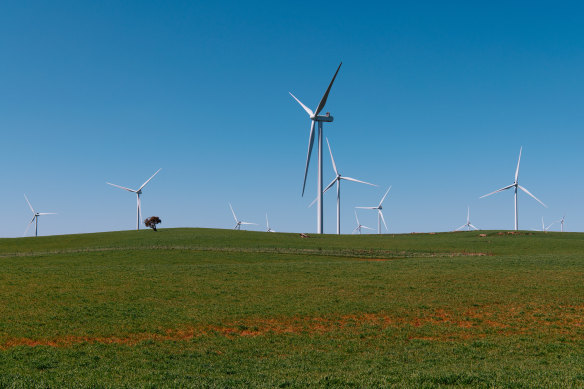The numbers behind Victoria’s big energy build
The scale of the challenge facing Victoria in reaching its emissions reduction target has been revealed, with forecasts the state will need 27 million additional solar panels, 900 onshore wind turbines and 1.4 million electric vehicle chargers by 2035.
A new document released by the Allan government, “Cheaper, Cleaner, Renewable: Our Plan for Victoria’s Electricity Future”, has outlined how the energy transition away from fossil fuels will lead to the state consuming 50 per cent more electricity in 10 years.

Victoria expects another 900 onshore wind turbines will be needed for the state’s energy transition.Credit: James Brickwood
Energy experts say the targets are achievable but have questioned whether they can be completed on time, as obstacles remain around determining who will ultimately bear the costs of the transition.
The document forecasts that by 2035, there will be a rising amount of electricity use through the conversion of gas products to electric and through transport, with the addition of 1.4 million electric cars and an equal amount of charging ports.
In a decade, the government expects electric vehicles to consume 8 terawatt hours of power every year. Another 7 terawatt hours have been linked to “electrification” – gas usage that will be replaced with electric.
To support this, about 11.4 gigawatts of new renewable generation projects will need to be plugged into the grid, with a total of 222 offshore wind turbines and 900 additional on land.
An additional 7.6 gigawatts is also expected to come from solar, which will add up to an extra 27 million solar panels across homes and generation projects. Another 3600 battery packs will be needed to help manage demand outside of peak periods of generation.
Victoria has set a target of 95 per cent renewable energy by 2035, but gas will still be part of the mix to shore up the network.
Brown coal stations are forecast to no longer be generating power by 2035, in line with a likely scenario published by the Australian Energy Market Operator. Alinta Energy, owner of Loy Yang B, has flagged that the plant’s closure date will be determined by market conditions and could continue past AEMO’s expectations.
Energy Minister Lily D’Ambrosio said the state had met all of its climate and energy targets to date and was on track to meet its next target, with renewable energy last year making up 39 per cent of Victoria’s energy capacity.
“Our initial $1 billion to accelerate the energy transition through the SEC, new streamlined approvals processes, Commonwealth Capacity Investment Scheme and critical work to plan out future renewable energy zones through VicGrid are helping us get on with our renewable energy big build.”
Tennant Reed, the director of climate change and energy at the Australian Industry Group, said the government’s targets were achievable, but it was still up in the air whether they could be completed on time as costs and delays troubled construction across the world.
He said developments such as Snowy Hydro 2.0 had shown that projects were harder to build than expected, but state and federal governments were making the right moves to improve approvals processes.
“It is a decent, substantial statement of the right set of priorities, it just comes down to walking the talk,” Reed said.
“There’s a much more measured recognition of the importance of gas supply security then has sometimes been the tone from Victorian government. They are clear that we will be needing gas for a while, even as demand comes down substantially.”
Gavin Dufty, national director of energy policy research at St Vincent de Paul, said the document had “a lot of high numbers” but more information was needed on how the cost of projects, including transmission lines to support them, would be passed on to customers.
“The detail about what that means for household bills have still got to be worked out,” he said.
“If private equity finances it all, consumers pay at the end of the day because they need a return. If government finances it all through consolidated revenue, it doesn’t turn up on an electricity bill [but] it turns up somewhere else.
Opposition energy spokesman David Davis said the paper was a “thin, vacuous sham”.
“It is not a detailed or serious response to Victoria’s deteriorating energy position where supply issues are to the fore and prices are surging, clobbering households, and driving industry from the state.
”There is still no proper overarching approach just a cobbling together of the already released positions highlighting the war on gas and the ideological position of the Allan government.“
The Morning Edition newsletter is our guide to the day’s most important and interesting stories, analysis and insights. Sign up here.